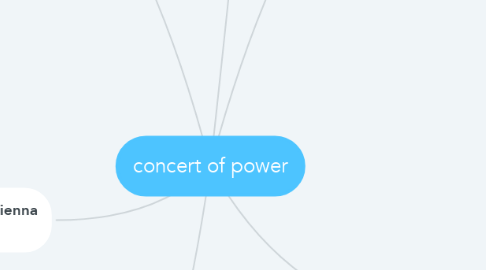
1. New Congress System (Vienna System)
1.1. took place from November 1814 to June 1815 in Vienna, Austria
1.2. designed to bring together the "major powers" of the time in order to stabilize the geopolitics of Europe after the defeat of Napoleon in 1813–1814
1.3. contain France's power after the war following the French Revolution
1.4. brought together representatives from over 200 European polities
1.5. The Congress of Vienna created a new international world order which was based on two main ideologies: restoring and safeguarding power balancing in Europe; and collective responsibility for peace and stability in Europe among the "great powers"
2. dominated by the five Great Powers of Europe, members of the Quadruple Alliance that defeated Napoleon.
2.1. Austria
2.2. France
2.3. Prussia
2.4. Russia
2.5. United Kingdom
3. purposes of formation
3.1. oppose revolutionary movements
3.2. weaken the forces of nationalism
3.3. lập lại một nền hòa bình lâu dài cho châu Âu bằng cách giải quyết những vấn đề phát sinh từ Chiến tranh Cách mạng Pháp và Chiến tranh Napoleon
3.4. thay đổi lãnh địa của các cường quốc để tạo thế cân bằng và duy trì hòa bình
4. build world order centered around Europe from 1814–1914
4.1. Phrase 1: from 1814 to the early 1860s
4.1.1. ending with the Prussian and Austrian invasion of Denmark
4.1.2. included numerous congresses, including the Congress of Paris in 1856 which some scholars argue represented the apex of the Concert of Europe in its ending of the Crimean War.
4.2. Phrase 2: from the 1880s to 1914
4.2.1. beginning with another attempt at alliances driven largely by German Chancellor Bismark
4.2.2. ending which resulted in the outbreak of World War 1
4.2.3. The creation of the Triple Alliance (which consisted of Germany, Austria-Hungary, and Italy) and the rival Triple Entente (which consisted of France, Russia, and Great Britain) => pitting European powers against each other.
5. how it is born
5.1. raised by figures such as Gottfried Leibniz, Lord Grenville, Metternich
5.2. ideas and the notion of a balance of power in international relations, so that the ambitions of each Great Power would be restrained by the others
5.3. derived from the final Act of the Vienna Congress, which stipulated that the boundaries established in 1815 could not be altered without the consent of its eight signatories.
5.4. anarchy (first used in 1539) meaning "an absence of government", refer to the curtailment or abolition of traditional forms of government and institutions, has no system of government or central rule.
5.5. Hòa ước Westfalen được hình thành, đưa đến một trật tự chính trị mới ở Trung Âu, quyền lợi của các quốc gia trở thành tối cao cả về luật pháp lẫn chính trị, nguyên tắc không can thiệp không được áp dụng
6. how it is ended
6.1. split itself into the Triple Alliance and the Triple Entente
6.1.1. Triple Alliance
6.1.1.1. an agreement between Germany, Austria-Hungary, and Italy.
6.1.1.2. It was formed on 20 May 1882 and renewed periodically until it expired in 1915 during World War I
6.1.1.3. Each member promised mutual support in the event of an attack by any other great power.
6.1.2. Triple Entente
6.1.2.1. meaning "friendship, understanding, agreement"
6.1.2.2. informal understanding between the Russian Empire, the French Third Republic and the United Kingdom
6.1.2.3. It built upon the Franco-Russian Alliance of 1894, the Entente Cordiale of 1904 between Paris and London, and the Anglo-Russian Entente of 1907
6.1.2.4. It formed a powerful counterweight to the Triple Alliance of Germany, Austria-Hungary, and Italy; was not an alliance of mutual defence.
6.2. its failure started First World War
6.2.1. rival alliances
6.2.2. the rise of nationalism
6.2.3. global war
6.2.4. from 1914 to 1918.
6.2.5. more than 70 million military personnel, including 60 million Europeans
6.2.6. largest wars, deadliest conflicts in history
6.2.7. cuộc chiến giữa phe Hiệp Ước (chủ yếu là Anh, Pháp, Nga, và sau đó là Hoa Kỳ, Brasil) và phe Liên Minh (chủ yếu là Đức, Áo-Hung, Bulgaria và Ottoman)
